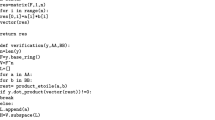Abstract
This paper describes a class of two-dimensional codes called cascaded Reed-Solomon (CRS) codes and an algorithm for decoding these codes up to their minimum distance. CRS codes are cascade (or generalized concatenated) codes in which Reed-Solomon codes are used for both the inner and outer codes. We introduce hyperbolic cascaded Reed-Solomon (HCRS) codes, which have maximal rate among CRS codes of a given minimum distance. Our algorithm decodes any CRS code to its minimum distance by calculating a Gröbner basis for an ideal which identifies the error locations. This error location algorithm is based on Sakata's algorithm, but with two significant modifications. First of all, the iterations and terms of polynomials are ordered according to the lexicographic ordering. Secondly, unknown syndromes are calculated as needed, by a simple threshold rule. Once the error locations are known, the error values can be calculated by solving an analog of the key equation for Reed-Solomon codes.
This work was supported in part by the U.S. Army Research Office through the Mathematical Sciences Institute of Cornell University, and in part by NSF grants NCR-8903931 and NCR-9207331.
Preview
Unable to display preview. Download preview PDF.
Similar content being viewed by others
References
S. Sakata, “Finding a minimal set of linear recurring relations capable of generating a given finite two-dimensional array,” J. Symbolic Computation, vol. 5, pp. 321–337, 1988.
S. Sakata, “Decoding binary 2-D cyclic codes by the 2-D Berlekamp-Massey algorithm,” IEEE Trans. Inform. Theory, vol. 37, pp. 1200–1203, July 1991.
S. Sakata, “A Gröbner basis and a minimal polynomial set of a finite nD array,” in Applied Algebra, Algebraic Algorithms, and Error-correcting Codes: Proceedings of AAECC-8, Tokyo, 1990 (S. Sakata, ed.). Berlin: Springer-Verlag, 1991.
B. Buchberger, “Gröbner bases: An algorithmic method in polynomial ideal theory,” in Multidimensional Systems Theory: Progress, Directions and Open Problems in Multidimensional Systems (N. K. Bose, ed.). Dordrecht, Holland: D. Reidel, 1985.
D. Cox, J. Little, and D. O'Shea, Ideals, Varieties, and Algorithms. New York: Springer-Verlag, 1992.
E. R. Berlekamp, Algebraic Coding Theory. New York: McGraw-Hill, 1968.
J. L. Massey, “Shift-register synthesis and BCH decoding,” IEEE Trans. Inform. Theory, vol. 15, pp. 122–127, Jan. 1969.
E. L. Blokh and V. V. Zyablov, “Coding of generalized cascade codes,” Probl. Info. Trans., vol. 10, pp. 45–50, 1974.
J. Wu and D. J. Costello Jr., “New multi-level codes over GF(q),” IEEE Trans. Inform. Theory, vol. 38, pp. 933–939, Jan. 1992.
R. Krishnamoorthy and C. Heegard, “Structure and decoding of Reed-Solomon based cascade codes,” in Proc. 25th Ann. Conf. Inform. Sci. Syst., pp. 29–33, 1991.
R Krishnamoorthy, Algorithms for Capacity Computations and Algebraic Cascade Coding with Applications to Data Storage. PhD thesis, Cornell University, Aug. 1991.
V. A. Zinoviev and V. V. Zyablov, “Decoding of nonlinear generalized concatenated codes,” Probl. Info. Trans., vol. 14, pp. 46–52, 1978.
Y. Sugiyama, M. Kasahara, S. Hirasawa, and T. Namekawa, “A method for solving key equation for decoding Goppa codes,” Inf. and Contr., vol. 27, pp. 87–99, 1975.
P. Fitzpatrick and J. Flynn, “A Gröbner basis technique for Padé approximation,” J. Symbolic Computation, vol. 13, pp. 133–138, 1992.
J. Justesen, K. Larsen, H. Jensen, and T. Høholdt, “Fast decoding of codes from algebraic plane curves,” IEEE Trans. Inform. Theory, vol. 38, pp. 111–119, Jan. 1992.
G.-L. Feng and K. K. Tzeng, “Decoding cyclic and BCH codes up to actual minimum distance using nonrecurrent syndrome dependence relations,” JEEE Trans. Inform. Theory, vol. 37, pp. 1716–1723, Nov. 1991.
G.-L. Feng and T.R.N. Rao, “Decoding algebraic-geometric codes up to the designed minimum distance,” IEEE Trans. Inform. Theory, vol. 39, pp. 37–45, Jan. 1993.
Author information
Authors and Affiliations
Editor information
Rights and permissions
Copyright information
© 1993 Springer-Verlag Berlin Heidelberg
About this paper
Cite this paper
Saints, K., Heegard, C. (1993). On hyperbolic cascaded Reed-Solomon codes. In: Cohen, G., Mora, T., Moreno, O. (eds) Applied Algebra, Algebraic Algorithms and Error-Correcting Codes. AAECC 1993. Lecture Notes in Computer Science, vol 673. Springer, Berlin, Heidelberg. https://doi.org/10.1007/3-540-56686-4_51
Download citation
DOI: https://doi.org/10.1007/3-540-56686-4_51
Published:
Publisher Name: Springer, Berlin, Heidelberg
Print ISBN: 978-3-540-56686-1
Online ISBN: 978-3-540-47630-6
eBook Packages: Springer Book Archive




